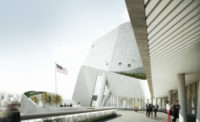Steven Holl Architects Selected for Kennedy Center Expansion






Ada Louise Huxtable, who died on January 7, derided the Edward Durell Stone-designed John F. Kennedy Center for the Performing Arts as “a great marble sarcophagus in which the art of architecture lies buried.” Now the Center has approved a plan by Steven Holl to bring the art of architecture back to life.
Holl’s proposed addition to the Center in Washington, D.C., will be largely underground, with three pavilions rising to the surface in a newly created park. The scheme resembles his hugely successful addition to the Nelson-Atkins Museum in Kansas City, though here the pavilions will be made of carved Carrara marble rather than glass.
The size of the addition, some 60,000 square feet—most of it office and rehearsal spaces—pales next to the 1.5 million square feet of the original building, which was completed in 1971. But the graceful pavilions, in what is now a parking lot, could have a big impact on how the Center is perceived. Unlike Stone’s “hermetically sealed box,” “we’re creating fragments open to views and light and natural ventilation,” Holl says.
One of the pavilions will have a flat wall that can be used for video projections, including simulcasts of performances inside the Center. Another will be a stage that floats on the Potomac River and is reached by two Holl-designed walkways over Rock Creek Parkway. Holl positioned the pavilions to frame views of the Lincoln and Jefferson Memorials and other Washington landmarks. The surrounding gardens will contain a number of references to the Center’s namesake, including a pool the length of Kennedy’s wartime vessel, P.T. 109.
The project is expected to cost $100 million, of which $50 million has been pledged by David M. Rubenstein, founder of the Carlyle Group, a private equity firm, and chairman of the Kennedy Center board. Rubenstein headed the Center's 10-member architect selection committee with Fred Eychaner, a Chicago businessman and architecture patron (Tadao Ando designed his house). The committee, which included two members of the Kennedy family, reportedly considered 21 firms. The finalists were Holl, working with partner Chris McVoy; Diller Scofidio + Renfro; and Pei Cobb Freed & Partners.
The project can expect smoother sailing than the Kennedy Center's last expansion plan. That project, announced in 2003 with a design by Rafael Viñoly, was budgeted at $650 million. Seeming grandiose even during economic boom times, it called for decking over highways that separate the Center from the city with a swoopy, four-block-long pedestrian plaza flanked by reflecting pools and large, curved buildings. But the project died in 2005, after Congress failed to appropriate the necessary funding. Congress authorized the current expansion last year on the condition that it be built entirely with private money. Holl says that the famously generous Rubenstein, who lives in nearby Bethesda, may contribute additional funds for a modest pedestrian bridge over the tangle of highways that Viñoly once hoped to obscure.







